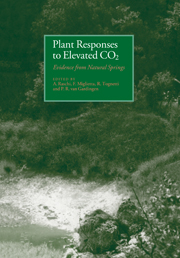Book contents
- Frontmatter
- Contents
- List of contributors
- Preface
- Sites of naturally elevated carbon dioxide
- Migration in the ground of CO2 and other volatile contaminants. Theory and survey
- Levels of CO2 leakage in relation to geology
- CO2 emission in volcanic areas: case histories and hazards
- Controlled degassing of lakes with high CO2 content in Cameroon: an opportunity for ecosystem CO2-enrichment experiments
- Burning coal seams in southern Utah: a natural system for studies of plant responses to elevated CO2
- Long-term effects of enhanced CO2 concentrations on leaf gas exchange: research opportunities using CO2 springs
- Using Icelandic CO2 springs to understand the long-term effects of elevated atmospheric CO2
- Plant CO2 responses in the long term: plants from CO2 springs in Florida and tombs in Egypt
- Acidophilic grass communities of CO2 springs in central Italy: composition, structure and ecology
- Studying morpho-physiological responses of Scirpus lacustris from naturally CO2-enriched environments
- Carbon physiology of Quercus pubescens Wild, growing at the Bossoleto CO2 spring in central Italy
- Preliminary results on dissolved inorganic 13C and 14C content of a CO2-rich mineral spring of Catalonia (NE Spain) and of plants growing in its surroundings
- The impact of elevated CO2 on the growth of Agrostis canina and Plantago major adapted to contrasting CO2 concentrations
- Stomatal numbers in holm oak (Quercus ilex L.) leaves grown in naturally and artificially CO2-enriched environments
- Effects of CO2 on NH4+ assimilation by Cyanidium caldarium, an acidophilic hot springs and hot soils unicellular alga
- Can rising CO2 alleviate oxidative risk for the plant cell? Testing the hypothesis under natural CO2 enrichment
- Increasing concentrations of atmospheric CO2 and decomposition processes in forest ecosystems
- Index
Using Icelandic CO2 springs to understand the long-term effects of elevated atmospheric CO2
Published online by Cambridge University Press: 10 February 2010
- Frontmatter
- Contents
- List of contributors
- Preface
- Sites of naturally elevated carbon dioxide
- Migration in the ground of CO2 and other volatile contaminants. Theory and survey
- Levels of CO2 leakage in relation to geology
- CO2 emission in volcanic areas: case histories and hazards
- Controlled degassing of lakes with high CO2 content in Cameroon: an opportunity for ecosystem CO2-enrichment experiments
- Burning coal seams in southern Utah: a natural system for studies of plant responses to elevated CO2
- Long-term effects of enhanced CO2 concentrations on leaf gas exchange: research opportunities using CO2 springs
- Using Icelandic CO2 springs to understand the long-term effects of elevated atmospheric CO2
- Plant CO2 responses in the long term: plants from CO2 springs in Florida and tombs in Egypt
- Acidophilic grass communities of CO2 springs in central Italy: composition, structure and ecology
- Studying morpho-physiological responses of Scirpus lacustris from naturally CO2-enriched environments
- Carbon physiology of Quercus pubescens Wild, growing at the Bossoleto CO2 spring in central Italy
- Preliminary results on dissolved inorganic 13C and 14C content of a CO2-rich mineral spring of Catalonia (NE Spain) and of plants growing in its surroundings
- The impact of elevated CO2 on the growth of Agrostis canina and Plantago major adapted to contrasting CO2 concentrations
- Stomatal numbers in holm oak (Quercus ilex L.) leaves grown in naturally and artificially CO2-enriched environments
- Effects of CO2 on NH4+ assimilation by Cyanidium caldarium, an acidophilic hot springs and hot soils unicellular alga
- Can rising CO2 alleviate oxidative risk for the plant cell? Testing the hypothesis under natural CO2 enrichment
- Increasing concentrations of atmospheric CO2 and decomposition processes in forest ecosystems
- Index
Summary
SUMMARY
The CO2-emitting mineral springs of Iceland have been surveyed and assessed for their use in understanding the potential effects of elevated atmospheric CO2 on northern ecosystems. One spring near Olafsvik is described in detail here. This CO2 spring emits CO2 in such a way that the surrounding vegetation is exposed to mean CO2 concentrations which are consistent with those predicted for the next century. Results from carbon isotope analyses show that Nardus stricta plants growing near this CO2 spring are exposed to mean CO2 concentrations of approximately 880, 650 and 430 ppm, depending on their location relative to the CO2 vent. Maps and tables are provided to show how the concentration of CO2 measured in the vegetation varies over time on calm and windy days. A list of the species growing around the Olafsvik CO2 spring is included and the research potential of CO2 springs is discussed at length. The use of natural CO2 springs as surrogates for elevated CO2 experiments appears highly promising.
INTRODUCTION
The concentration of carbon dioxide in the atmosphere is increasing due to the burning of fossil fuels and deforestation. How plants evolve in response to elevated CO2 and global climate change will ultimately affect many of the important responses of the biosphere including primary productivity, trace gas flux, and vegetation boundaries.
- Type
- Chapter
- Information
- Plant Responses to Elevated CO2Evidence from Natural Springs, pp. 87 - 102Publisher: Cambridge University PressPrint publication year: 1997
- 3
- Cited by

